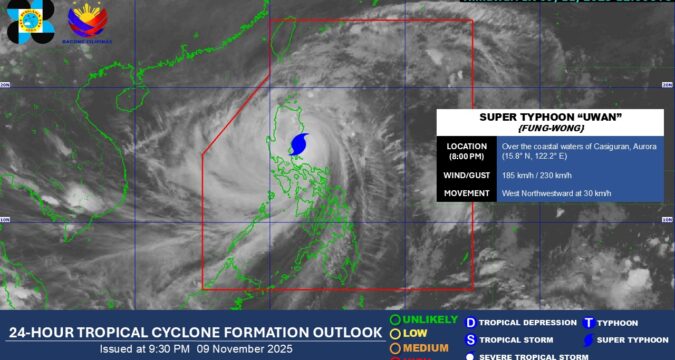
MANILA (Agencies): Super Typhoon Fung-wong barreled into the Philippines on November 9 with sustained winds of 185 kph and gusts reaching 230 kph. The Philippine weather agency, PAGASA, warned of a “high risk of life-threatening” storm surges and rainfall exceeding 200mm in parts of Luzon, ABS-CBN News, reported.
By the time Fung-wong moved over the South China Sea toward Taiwan on 10 November, at least two people had been killed, according to reports from Rappler and ABS-CBN News.
As the typhoon departed the Philippines over the South China Sea on November 10, its effects had killed at least two people and forced 1.4 million people to evacuate.
Fung-wong made landfall in Aurora province on the evening of November 9 as a super typhoon, its massive footprint spanning nearly the entire country, uprooting trees and swamping towns in its path. Schools and government offices across Luzon, including Manila, closed on November 10.
“We’re seeing many damaged houses and some of our main roads were not passable due to landslides,” rescue worker Geofry Parrocha said on November 10 from Dipaculao, Aurora, where power had yet to be restored.
As the typhoon departed the Philippines over the South China Sea on November 10, its effects had killed at least two people and forced 1.4 million people to evacuate
“We couldn’t mobilise last night because the rain was heavy and the volume of water was high,” he added. Officials were only now able to assess the damage.
Aurora Taay, mayor of Dingalan, told a Facebook Live audience that numerous houses and boats along the shoreline were smashed by massive waves.
Fung-wong struck just days after Typhoon Kalmaegi swept through the central Philippines, claiming at least 224 lives.
Catanduanes was battered by wind and rain early on November 9, with storm surges flooding streets and homes.
As we celebrate the 500 years of Christianity in the Philippines. The Chaplaincy to Filipino Migrants organises an on-line talk every Tuesday at 9.00pm. You can join us at:
https://www.Facebook.com/CFM-Gifted-to-give-101039001847033
“The waves started roaring around 7:00am. When the waves hit the seawall, it felt like the ground was shaking,” Edson Casarino, a resident of Virac, said.
Samar province, hard hit by Kalmaegi the week before, recorded the first known fatality from Fung-wong on November 9.
Scientists warn that climate change is making storms more powerful. Warmer oceans allow typhoons to strengthen rapidly and the atmosphere holds more moisture, causing heavier rainfall Reuters reported
Juniel Tagarino, a rescuer in Catbalogan City, said the body of a 64-year-old woman attempting to evacuate was found under debris and fallen trees.
“The wind was so strong and the rain was heavy… According to her family, she might have forgotten something and went back inside her house,” Tagarino said.
The civil defence office later confirmed a second death: a person who drowned in a flash flood on Catanduanes island. Parish churches on the island had opened their doors to those seeking shelter.
Further north, in Cagayan province, people sheltering in an evacuation centre said that fear of flooding had convinced them to leave their homes.
“We often suffer flooding in our home, so when we were told to evacuate, we evacuated, because we would be trapped,” Loretta Salquina said.
Major flooding was also reported in southern Luzon’s Bicol region.
In Guinobatan, Albay province, video showed streets transformed into raging torrents.
Days earlier, Typhoon Kalmaegi sent floodwaters through Cebu and Negros, sweeping away cars, shanties and shipping containers.
Scientists warn that climate change is making storms more powerful. Warmer oceans allow typhoons to strengthen rapidly and the atmosphere holds more moisture, causing heavier rainfall Reuters reported.



